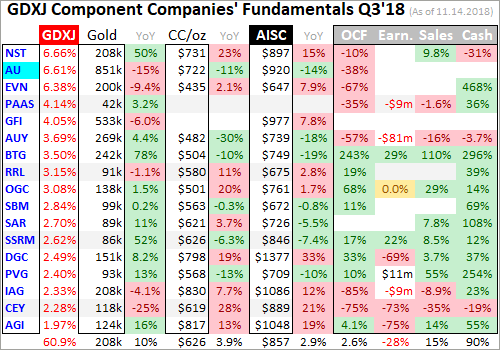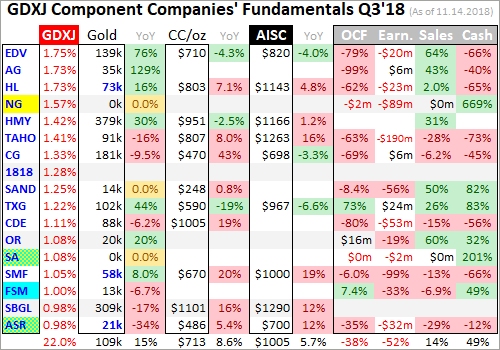Next comes gold miners’ most-important fundamental data for investors, cash costs and all-in sustaining costs per ounce mined. The latter directly drives profitability which ultimately determines stock prices. These key costs are also followed by YoY changes. Last but not least the annual changes are shown in operating cash flows generated, hard GAAP earnings, sales, and cash on hand with a couple exceptions.
その次は金鉱会社でもっとも重要なファンダメンタルズ、キャッシュコストとAISCだ。後者は直接収益につながらうために株価への影響が大きい。これらの重要指標のYoY変化も示している。最後に営業利益、GAAP会計利益手元資金とその変化を示す。
Percentage changes aren’t relevant or meaningful if data shifted from positive to negative or vice versa, or if derived from two negative numbers. So in those cases I included raw underlying data rather than weird or misleading percentage changes. This whole dataset together offers a fantastic high-level read on how the mid-tier gold miners as an industry are faring fundamentally. They actually did relatively well in Q3.
パーセント変化は正負が反転したときには意味を持たないし、双方がマイナスのときも意味を持たない。そういう場合にはパーセントではなく生データを示した。この表を俯瞰することで中規模金鉱会社のファンダメンタルがどうだったかがわかる。Q3には実際かなり良好だった。


While this new mid-tier GDXJ is generally excellent, some decisions by its managers are utterly baffling. Out of all the world’s gold miners they could’ve added over this past year, they inexplicably decided on the giant largely-African AngloGold Ashanti. It produced an enormous 851k ounces of gold last quarter, the largest in GDXJ by far. It and the rest of the South African majors definitely don’t belong in GDXJ!
この新たな中規模GDXJは結構行けているが、ETF管理者の判断のいくつかは全く馬鹿げている。彼らはここ数年世界の金鉱山をを組み込んだが、アフリカの巨大金鉱山AngloGold Ashantiを組み込んだのはおかしなことだ。この会社は直近四半期に851Kオンスものゴールドを産出している、GDXJの中では最大だ。この会社と南アフリカの大手は絶対GDXJに組み込むべきではない!
Remember that major-gold-miner threshold has long been 1m+ ounces per year. AU’s production is annualizing to well over 3x that, making this company the world’s 3rd-largest gold miner last quarter. Why on earth would managers running a “Junior Gold Miners ETF” even consider AngloGold Ashanti? It is as far from junior-dom as gold miners get. The same is true with the rest of the troubled South African gold miners.
大手金鉱会社の境目は年産1Mオンス超だ。AUの生産量はこの3xにもなる、直近四半期では世界3位の金鉱会社だ。一体どうして管理者は「小型金鉱株ETF」にAngloGold Ashantiを組み込むのか?小型金鉱株の範疇からはあまりに外れている。それは問題のある南アフリカの金鉱山も同様だ。
AU, Gold Fields, Harmony Gold, and Sibanye-Stillwater mined 851k, 533k, 379k, and 309k ounces in Q3’18, all are majors. Yet they accounted for 13.1% of GDXJ’s total weighting. They are riddled with all kinds of problems too, from shrinking production to high costs to increasing stealth expropriations from South Africa’s openly-Marxist anti-white-investor government. Their inclusion heavily skews and taints GDXJ.
AU、Gold Fields,Harmony Gold、そしてSibanye-Stillwaterは2018Q3に851k, 533k, 379k, and 309kも産出している、どれも大手だ。これらを合算するとGDXJの時価総額の13.1%にもなる。これらの企業はどれも問題を抱えている、生産量縮小によるコスト増だ、また南アフリカのマルクス主義反白人政府から接収の脅威を受けている。これらの銘柄を組み込むことでGDXJは大きく歪め傷ついている。
These South African majors’ Q3 production of 2.1m ounces was a whopping 41% of the GDXJ top 34’s total! And it still fell 7.0% YoY due to South Africa’s tragic death spiral. Excluding them and the amazing Kirkland Lake Gold which has grown so fast it was moved exclusively into GDX over this past year, the rest of the GDXJ top 34 grew production 3.4% YoY in Q3. The South African majors’ cost impact is even worse.
これらの南アフリカ大手のQ3生産量は2.1MオンスにもなりGDXJ上位34銘柄のなんと41%にもなる!南アフリカでの負のスパイラルによりYoYで7.0%も減らしている。これらの企業と急成長のためにGDXに移行したKirkland Lake Goldを除外すると、GDXJ上位34の残りの企業はQ3生産量をYoYで3.4%増やしている。南アフリカ大手のコストインパクトはとても悪いものだ。
Mining in that country is very expensive thanks to very-old very-deep mines and endless new government interference via stifling regulations. In Q3 the South African majors’ cash and all-in sustaining costs came in really high averaging $925 and $1088 per ounce. The rest of GDXJ’s top 34 averaged $629 and $877, a massive 32.0% and 19.4% lower! The South African majors are really retarding GDXJ’s performance.
この国での採掘はとても高価になりつつある、その原因はとても古く深い鉱山のためと政府が規制を頻繁に更新するためだ。南アフリカ大手のQ3キャッシュコストとAISCは平均すると$925と$1088/オンスだ。GDXJ34銘柄の残りの平均は$629と$877であり、なんと32.0%と19.4%も低い!南アフリカ大手が本当にGDXJのパフォーマンスを下げている。
As struggling majors far larger than mid-tiers and juniors, they need to get kicked out of GDXJ posthaste. They can be left in GDX where they belong. AU effectively took KL’s place, which makes no sense at all fundamentally. Kirkland Lake produced 180k ounces of gold in Q3 at $351 cash costs and $645 AISCs. So unlike AU, KL remains solidly in the mid-tier realm and has been performing incredibly well operationally.
中規模企業に比べ大手は困っている、これらの銘柄はGDXJから急いで除外すべきだ。それらの銘柄はGDXに属するものだ。AUはKLに取って代わった、ファンダメンタルズからすると馬鹿げている。Kirkland LakeはQ3に180Kオンスを産出下がキャッシュコストは$351そしてAISCは$645だ。AUと違い、KLは中規模のままでありとても良好な実績を示している。
While GDXJ’s managers really dropped the ball including those South African majors, they deserve big praise for upping the weighting of the outstanding Australian miners. They are Northern Star Resources, Evolution Mining, Regis Resources, St Barbara, and Saracen Mineral. Their collective weighting in GDXJ grew to 21.7% at the end of Q3’s earnings season, nearly 2/3rds higher from their 13.3% a year earlier.
GDXJ管理者は実際南アフリカ大手でヘマをやったが、オーストラリアの鉱山比率を増やしたことは称賛すべきだ。それらの銘柄は、Northern Star Resources,Evolution Mining、Regis Resources,St Barbara、そしてSaracen Mineralだ。GDXJにしめるこれらの割合はQ3末において21.7%で、一年前の13.3%から2/3増えている。
Unlike AU’s dumbfounding inclusion, the Australians’ rise is well-deserved. Their production surged 8.9% YoY to 686k ounces, or 23% of the GDXJ top 34’s total excluding those South African majors. And the Australian miners are masters at developing great gold deposits and controlling costs, as their cash costs and AISCs in Q3 averaged just $586 and $724! It’s fantastic GDXJ offers American investors this Aussie exposure.
AUを組み込んでいることは唖然とするが、オーストラリアの割合を増やしたことは素晴らしい。それらの生産量はYoYで8.9%増えて686オンスとなった、南アフリカ大手を除くGDXJ上位34銘柄の23%にもなる。そしてオーストラリア鉱山はすばらしい金鉱脈を開発しておりコスト管理ができている、Q3における平均キャッシュコストは$586であり平均AISCは$724だ!オーストラリアの露出を増やすことでGDXJは米国投資家に素晴らしい恩恵を与えている。
GDXJ’s component list and weightings are a work in progress, and are gradually getting better. For years I’ve pointed out things like the South African majors that weren’t right, and GDXJ’s managers eventually seem to come around and change things for the better. Greatly helping that process is investors buying the better individual stocks like KL and shunning laggards like AU, readjusting their relative market capitalizations.
GDXJ組み込み銘柄とその割合は現在も変化している、そして徐々に改善されている。長年私は南アフリカ大手の問題を指摘しておりこれは正しかった、そしてGDXJ管理者は徐々に良い方向に変化しているように見える。この一連の仮定で投資家はKLのような優良銘柄を増やしAUのような遅れをとった銘柄の露出を減らしている、時価総額比率を調整することにより。
GDXJ and GDX are essentially market-cap weighted, with larger companies rightfully commanding larger weightings. These leading gold-stock ETFs’ managers can override this by deciding which gold miners to include in each ETF. So they can easily purge GDXJ of the deteriorating South African majors and add real mid-tier gold miners. But the true core problem is having so many of the same stocks in GDX and GDXJ.
GDXJとGDXはともに時価総額で比重を決めており、時価総額の大きな会社が大きな割合を占める。これらの金鉱株ETF管理者はどの銘柄を組み込むかを決めることでこれを調整できる。というわけで彼らはGDXJから南アフリカ大手を除外することは簡単で本当の中規模鉱山を加えることができる。しかし問題の本質はあまりに多くの銘柄がGDXとGDXJに重複していることだ。
Such massive overlap between these two ETFs is a huge lost opportunity for VanEck. It owns and manages GDX, GDXJ, and even the MVIS indexing company that decides exactly which gold stocks are included in each. With one company in total control, there’s no need for any overlap in the underlying companies of what should be two very-different gold-stock ETFs. Inclusion ought to be mutually-exclusive.
2つのETFの間でのここまで大きな重複はVanEckにとっても損失だ。当社はGDXとGDXJ双方を運用しており、指数を決めるMVIS社も所有している。一社が全体をコントロールしているわけで、2つの異なる性質のETFで重複銘柄を保つ必要はない。組み込み銘柄は排他的にすべきだ。
VanEck could greatly increase the utility of its gold-stock ETFs and thus their ultimate success by starting with one big combined list of the world’s better gold miners. Then it could take the top 20 or 25 in terms of annual gold production and assign them to GDX. Based on Q3’18 production, that would run down near 139k or 93k ounces per quarter. Then the next-largest 40 or 50 gold miners could be assigned to GDXJ.
VanEckは2つの金鉱株ETFの有用性を増すことができる、それにはまず世界的有料金鉱会社のリストを作ることだ。そしてその生産量の上位20−25をGDXに組み込目ば良い。2018Q3の生産量を見ると、四半期生産量が139kオンスから93Kオンスの範疇となる。そしてその次に大きな40から50位金鉱会社をGDXJとすればよい。
Getting smaller gold miners back into GDXJ would be a huge boon for the junior-gold-mining industry. Most investors naturally assume this “Junior Gold Miners ETF” owns junior gold miners, which is where they are trying to allocate their capital. But since most of GDXJ’s funds are instead diverted into much-larger mid-tiers and even some majors, the juniors are effectively being starved of capital intended for them.
相対的に小規模の銘柄をGDXJに組み込むことで人気がでるだろう。ほとんどの投資家は当然ながら「小型金鉱株ETF」には小型金鉱銘柄が組み込まれていると思っている、これこそ彼らが資金を投じたい分野だ。しかしGDXJの資金の多くはもっと大きな中規模鉱山に投じられており場合によっては大手金鉱株だ、というわけで小型金鉱会社は資金不足に悩むことになる。
That’s one of the big reasons smaller gold miners’ stock prices are so darned low. They aren’t getting enough capital inflows from gold-stock-ETF investing. So their share prices aren’t bid higher. They rely on issuing shares to finance their exploration projects and mine builds. But when their stock prices are down in the dumps, that is heavily dilutive. So GDXJ is strangling the very industry its investors want to own!
小型金鉱株がここまで下落する原因の一つはここにある。彼らは金鉱株ETFから十分な資金流入恩恵を受けていない。そのため株価が上がらない。小型金鉱会社は新株発行で探査プロジェクトや鉱山建設費用を賄う。しかし株価が下落していると、新株発行は希薄化を招く。そのためGDXJを投資家が持ちにくくしている!









